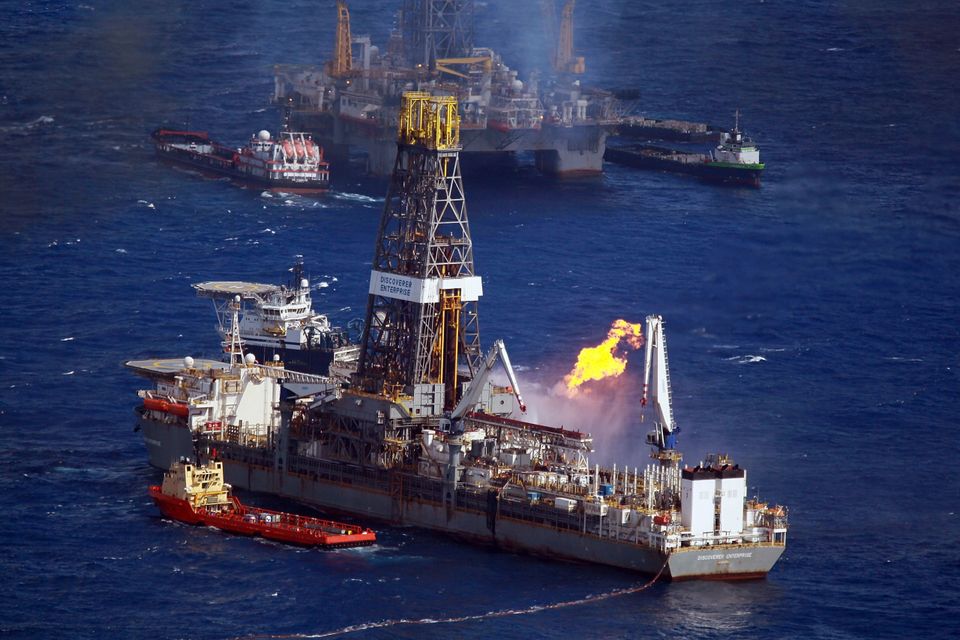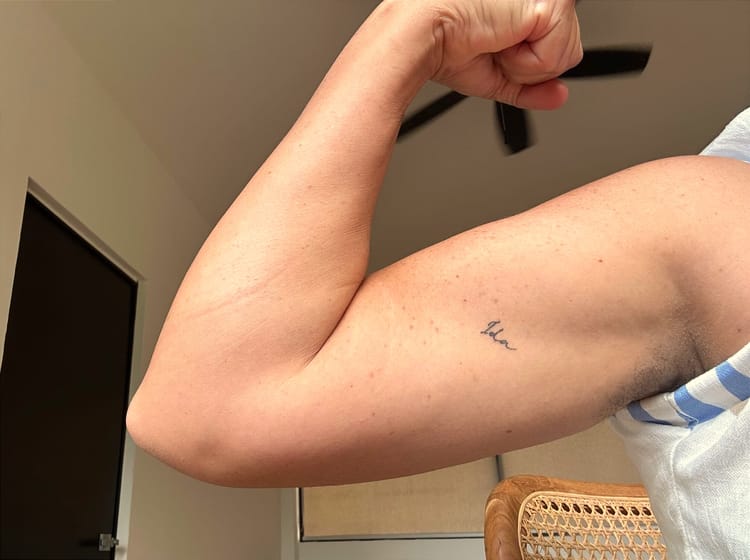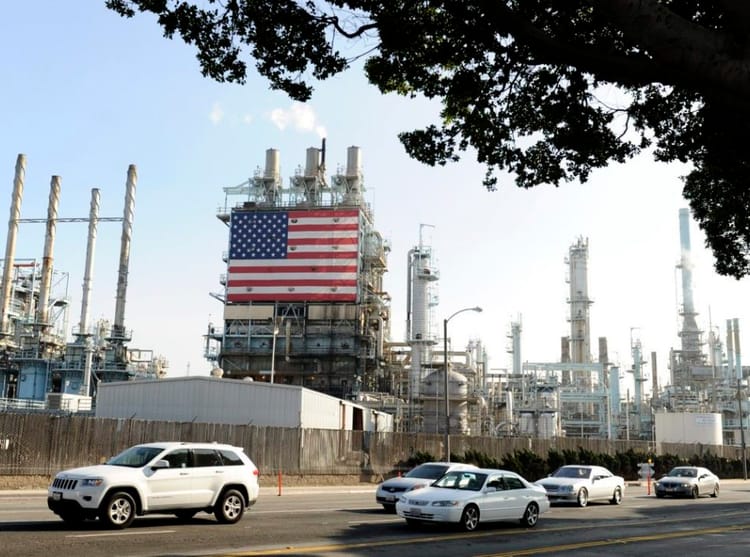Drilled Down: Offshore oil and gas worker fatalities are underreported by federal safety agency

By Sara Sneath
GULF OF MEXICO - JULY 03: The Discoverer Enterprise drilling rig is seen as it continues the effort to recover oil from the Deepwater Horizon spill site on July 3, 2010 in the Gulf of Mexico off the Louisina coast. Millions of gallons of oil have spilled into the Gulf since the April 20 explosion on the drilling platform. (Photo by Joe Raedle/Getty Images)
Nearly half of known Gulf of Mexico worker fatalities didn’t fit the agency’s reporting criteria
This story is a collaboration between Drilled News, Southerly, and WWNO.
Leo Linder felt safer on BP’s Deepwater Horizon than he had on other offshore oil drilling rigs. On April 20, 2010, he ended his shift and went to his sleeping quarters two hours before the platform exploded, killing 11 workers and triggering one of the worst environmental disasters in U.S. history. The man who replaced him was among the crew members who died.
“I’m cynical, but I really thought the system would work,” he said. “There were certainly signs in hindsight. My faith in the system working was pretty solid, even after the initial explosion I couldn’t fathom it was a blowout.”

The explosion in the Gulf of Mexico, which spilled 4 million barrels of oil, has come to symbolize the riskiest era in offshore drilling because the spill spurred new safety and environmental regulations designed to balance the government’s role in developing offshore energy with its job to protect workers and natural resources. At the root of the spill were mistakes made by BP, Halliburton, and Transocean that called the entire industry’s safety culture into question, according to a national commission report released four months after the well head was plugged.
In the wake of the disaster, the federal government created the Bureau of Safety and Environmental Enforcement, or BSEE, to improve safety and enforce environmental regulations in the offshore oil and gas industry. However, an investigation by Drilled News and Southerly found that the number of offshore worker deaths is being undercounted by the agency. Inconsistent and missing data, as well as loopholes that allow some fatalities to go unreported, make the offshore industry appear safer than it really is.
Nearly half of known offshore worker fatalities in the Gulf of Mexico from 2005 to 2019 didn’t fit BSEE’s reporting criteria, according to data provided by the agency in response to a Freedom of Information Act request. On top of that, offshore jobs have been in decline since 2011 despite an increase in the amount of oil being produced offshore, making the jobs that remain more dangerous.
Even with this undercount, the most recent data released by the agency in April indicates there were six offshore worker fatalities in 2019—a higher number than they’ve reported in a single year since 2010. But these reports on BSEE’s website, which date back to 2006, don’t match its own raw data. There were three additional deaths among offshore workers not reported by BSEE in 2019, including two in a helicopter crash heading out to a rig and one that law enforcement determined was not work related.
The agency does not count offshore fatalities that occur in state waters, or deaths that occur while workers are in transport to offshore facilities. They don’t count deaths that happen on offshore platforms that aren’t work related, either, even though the remoteness of offshore platforms makes it more difficult to seek medical attention and workers often stay on platforms for two weeks at a time. For instance, in April 2021, six men died and seven went missing after a lift boat capsized on its way to an oil and gas lease in the Gulf. They won’t be counted towards the 2021 offshore fatality statistic, a BSEE spokesman said.
An agency spokesman said BSEE would correct the reported number of fatalities for three years based on reporting for this story. BSEE did not respond to questions about why it doesn’t count workers who die in state waters on their way out to platforms or who have medical emergencies while offshore.
Of the 83 known offshore worker fatalities that occurred between 2005 and 2019, about 30% — or 24 deaths — were classified as “non-occupational.” The non-work related fatalities during this period occurred an average of 60 miles away from shore, according to our analysis.
In order for BSEE to determine that a death wasn’t work related, the agency conducts an investigation. Until the investigation is complete, BSEE counts the fatality. But the agency may later subtract the number if it’s determined the death wasn’t work related, according to an agency spokesman. For example, in November 2018, a crewmember was working on a platform 30 miles from shore when he fell to the deck around 9 p.m. Other workers ran to him and performed CPR after they heard his tools fall. But they couldn’t revive him, according to a U.S. Coast Guard incident investigation report.
An autopsy report later determined the worker’s cause of death was a heart attack. His death was classified as “non-occupational,” and is not included in BSEE’s offshore incident statistics. Studies show that people who work night shifts are at greater risk for heart attacks.
BSEE doesn’t require companies to report worker deaths that occur in state waters. Most states control up to three nautical miles from their coastline; Florida and Texas control nine. Federal waters begin where state waters end and extend 200 nautical miles offshore.
We could not find a state agency in Louisiana or Texas that tracks offshore worker deaths either. Spokesmen for the Louisiana Department of Natural Resources and the Louisiana State Police said their agencies don’t track offshore worker deaths in state waters, nor does the Railroad Commission of Texas, an agency charged with regulating offshore drilling in Texas waters, according to spokesman Andrew Keese. He said the Occupational Safety and Health Administration, or OSHA, tracks this data; OSHA did not respond to requests for comment.
In congressional testimony following the BP oil spill, OSHA’s Assistant Secretary at the time, David Michaels, said that the agency had “no regulatory or enforcement authority” over offshore drilling rigs or production platforms. While the Bureau of Labor Statistics captures data on fatalities in the oil and gas sector, the information is not separated out by offshore and onshore work.
It’s unclear whether the U.S. Coast Guard tracks offshore worker deaths in state waters either. “We might track those numbers depending on the nature of the fatality, ” said USCG Sector New Orleans spokesman John Michelli. A Freedom of Information Act request for the data, filed July 13, has not been fulfilled.
Offshore worker deaths are preventable and should not be difficult to confirm, said Kelly Kryc, a senior fellow for the Center for American Progress, who worked for BSEE up until 2018. “There should be zero,” she said. “Nobody should lose their life on these platforms.”
Oil and gas companies say the offshore industry is safer than ever. “Offshore work has continued to become safer over time and this is reflected in the data, regulations, and operations,” said Erik Milito, the president for the National Ocean Industries Association, an industry group that represents oil companies including Shell, Chevron, and ExxonMobil. Milito added that BSEE has “worked closely with the industry to improve and build upon the safety data,” and the agency requires them to submit performance data. When asked about fatalities the association counts, he directed Drilled News and Southerly to BSEE data.
Milito touted voluntary programs promoted by BSEE designed for companies to confidentially share near misses and receive safety alerts as evidence of the federal agency’s commitment to preventing accidents. “The priority and objective is always zero incidents and zero spills, and the offshore energy industry is constantly looking at new ways to protect workers and the environment,” he said.
There is little evidence to support the claim that the work has gotten safer, however. The overall self-reported rate of injuries per hours worked for operators dropped by 53% between 2011 and 2019. But about 80% of workers are employed by contractors, not operators. While the rate of spills, fires and loss of well control were trending downward, they all increased from 2017 to 2019, according to self-reported data.
Four of the offshore workers who died in 2019 fell from platforms. In May 2019, a worker on the night shift fell through a corroded section of grating on a platform 80 miles off the coast of Louisiana. Less than 24 hours earlier, a supervisor noticed the section of grating was deteriorating and felt “spongey” underfoot, according to an investigation report. Despite having the materials necessary to fix the grating, the supervisor prioritized other work and tied a piece of red tape to the grating until it could be fixed.
Though it was company policy to initiate a search and rescue if a worker missed a check-in, an offsite company safety officer failed to do so when the worker missed check-ins at 2 a.m. and 4 a.m. The U.S. Coast Guard was not notified of the incident until 6:30 a.m.
Offshore drilling was developed in the Gulf of Mexico because of its shallow waters. In 1947, the first well drilled far enough offshore that it could not be seen from land was completed in 14 feet of water, according to a Bureau of Ocean Energy Management report. More than a decade later, technological advances enabled the industry to drill in 1,000 feet of water. About 15% of U.S. oil was produced offshore in 2020, according to the Bureau of Ocean and Energy Management.
President Joe Biden signed an executive order last year to suspend new oil and gas leases on federal lands and waters to address climate change. The extraction and combustion of fossil fuels pulled from public lands and waters accounts for about 20% of U.S. greenhouse gas emissions, according to a 2016 U.S. Geological Survey report. Carbon emissions from production in federal waters of the Gulf of Mexico accounted for 19% of the total in 2014. The most recent report from the Intergovernmental Panel on Climate Change clearly states that “reaching at least net zero CO2 emissions, along with strong reductions in other greenhouse gas emissions” is necessary to limit global warming.
A federal judge in Louisiana overturned the moratorium on new federal leases in June, after Louisiana Attorney General Jeff Landry led a group of 13 Republican attorneys general in filing suit, claiming that it would kill jobs. Gov. John Bel Edwards, a Democrat, testified before a U.S. Senate Committee in May that a long-term moratorium on new offshore oil and gas leases would result in job losses. “We want the resumption, and we want it as soon as possible so that the worst impacts don’t happen,” he said at the hearing. “And that these people don’t lose their chance at supporting themselves and their families.”
But Bureau of Ocean Energy Management director Amanda Lefton said it’s a more nuanced story. “We’re actually seeing a decline of jobs in the oil and gas industry over the years, in the past four years in particular,” she testified.
BSEE tracks offshore employment by work hours. The amount of offshore work hours dropped by more than 40% between 2011 to 2019, according to BSEE data. During that same period, the amount of oil produced offshore—measured in barrels of oil—increased by nearly 40%. The drop in oil prices and use of automation have led to reductions in the oil and gas workforce. Robots are expected to cause further job cuts in the future.
This week the Department of Interior announced that the Department of Justice has appealed the district court’s decision to lift the ban on new leases. Current federal programs do not adequately account for the impact of greenhouse gas emissions from federal oil and gas leases offshore and onshore, according to the agency’s statement. In the past three years, the Government Accountability Office has highlighted deficiencies with “decommissioning liabilities, safety and environmental oversight, fiscal returns from the leasing program, and pipeline safety and decommissioning in the offshore program,” the statement reads.
Even with missing data on fatalities, the number of reported deaths in 2019 is more than the previous five years combined, despite a drop in the number of people working offshore. This shrinking workforce is one reason that the job is dangerous, said Mathew Shaffer, a Houston-based personal injury lawyer who represents offshore workers. “We see injuries because there wasn’t enough crew. The men have to work harder just to keep up,” he said “A lot of those injuries are caused by the lack of manpower.”
When injuries and fatalities do occur, workers are often blamed, Shaffer said. As soon as an incident occurs, the companies fly a lawyer out to the rig or port of entry to secure statements that can later be used against them. When there is an injury settlement, the payment amount is often kept confidential. “I think the general public has very little idea of how dangerous these jobs are,” he said. “There’s just so many things that can go wrong.”
In 2019, environmental groups filed suit against BSEE and the Department of the Interior for repealing regulations that were written after the Deepwater Horizon explosion to prevent another disaster. A similar suit filed in 2020 argues that the trend toward drilling in deeper waters increases the risk of well blowouts and catastrophic oil spills.
Technological advances that allow companies to find deep mineral deposits and work under higher pressure have kept offshore drilling profitable. BP’s senior vice president over Gulf operations recently told Reuters that the company planned to increase the amount of oil it produces from the Gulf from 350,000 barrels per day to 400,000 barrels per day over the next five years.
Under the Trump administration, BSEE considered the financial burden federal safety regulations had on industry when rolling back rules established after the Deepwater Horizon explosion. The agency estimated the 2019 repeals would save the industry $152 million over a decade. The fact that cost savings were considered in writing the safety regulations is a sign that the federal agency has reverted to thinking like an investor, like before the Deepwater Horizon exploded, Linder said.
“This is not a disinterested body whose only concern is safety,” he said. “There seems to be an attitude that people who pay the bills should have the power to decide what risk their workers should take.”
This story is part of a series examining oil and gas industry efforts to undermine the transition away from fossil fuels in the Gulf of Mexico. The series is supported by a grant from the Fund for Investigative Journalism.
Sara Sneath is an investigative journalist based in Louisiana





